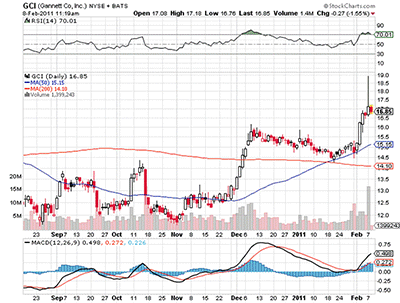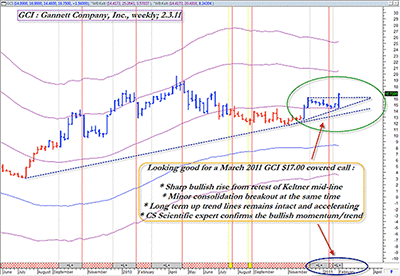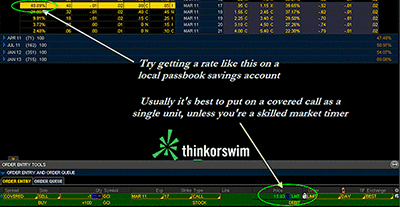The print media industry has been hit very hard over the last few years, with many old-line newspaper stalwarts either cutting back on operations or just shutting down completely. Gannett Co (GCI), best known for its USA Today newspaper, saw its share price cut by more than 95% between April 2004 and March 2009 before slowly regaining traction, eventually clawing its way back up to about $16.75, where it sits today.
While it may take a long time for shares of the stock to ever reach the $90 zone again, the fact remains that GCI is offering one of the better short-term covered-call plays available to savvy investors and traders. Here's a closer look in Figure 1 below.
Anytime you can find a near-term covered-call set-up offering an annualized rate of return of 40% (or better) in a liquid, big-cap stock, it always pays to do some further investigation to see if the risk/reward ratio is commensurate with such a fabulous profit opportunity.
In this case, a little extra due diligence appears to be well worth the effort, judging from the very solid technical posture of GCI on its weekly time frame. It looks like a very normal (and very bullish) breakout from a consolidation pattern that allowed for a minor retest of the Keltner midline and also provided the foundation for a wide-range breakout bar.
All this is occurring even as the trend lines are beginning to accelerate higher and the CS Scientific expert advisor (standard in MetaStock 10 and 11) is confirming the strongly bullish trend/momentum characteristics in shares of this media giant. That's the technical side of the trade, but how good are the covered call plays for GCI?
Article Continues on Page 2
|pagebreak|Actually, they're also looking mighty fine; a slightly out-of-the-money covered call—the March $17.00 —is offering a potential for an annualized rate of return of more than 40% (before commissions) for a 42-day time and capital commitment (see Figure 2 above). The bid/ask spread on the $17.00 call is only a nickel, and that's just what we want to see so we can limit risk and maximize potential gains should the trade go favorably. Limiting risk might mean nothing more difficult than using the new weekly uptrend line as a stop-loss barrier, just like a trailing stop. If GCI makes a weekly close below the line at any point before March expiration (March 18, 2011), the big idea is to close the trade out, win or lose.
Unless GCI sells off especially hard (it could happen; remember, this is the stock market, where anything can happen), the losses will likely be modest and you can always regroup and search for another promising trade set-up. Of course, if GCI stays above the line, just hold the trade and root for it to close in the money by the third Friday in March.
If you have a $30,000 stock trading account and want to limit your risk to 1.5% of its value ($450), here's a rough guide to help you determine how many covered calls you could purchase on this set-up.
Let's say the nominal initial stop-loss (using the current position of the uptrend line) is about $13.90. Using the risk profile graph in thinkorswim, I was able to determine that such a stop-loss point would equate a $210 loss per covered call, before commissions. So if I was willing to risk $450 on this trade, I could go long two March $17.00 covered calls in GCI and still be within my risk tolerance. If your risk tolerance was only 1% of your account value ($300), then you'd only want to buy one covered call— better safe than sorry.
It's no fun to miss out on a big winning trade, but it certainly beats having too large a position on when the market is setting up for a losing trade.
Play it safe: Size your positions on the conservative side, no matter what you trade (stocks, options, futures, forex, etc.). Over time, you may still be trading and making money long after the big risk-takers have closed out what was left of their own trading accounts.
By Don Pendergast of ChartW59.com
























